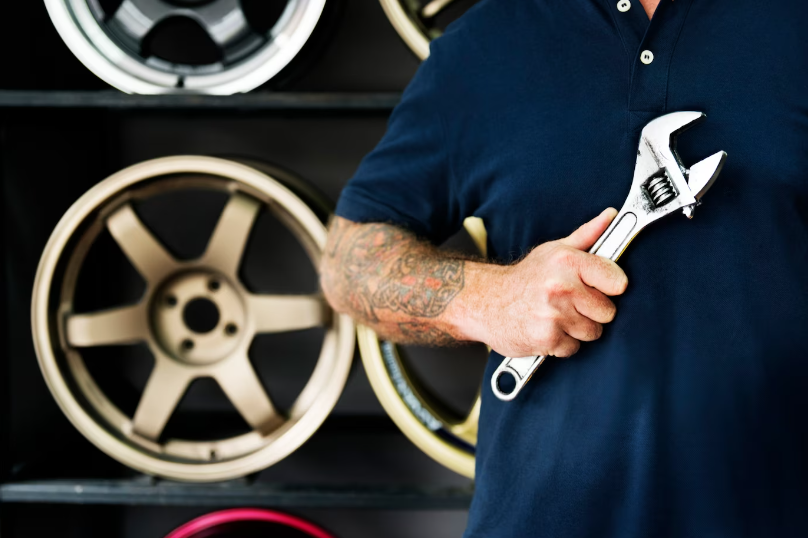Inspecting Your Brakes: DIY Tips and Signs of Wear

Brakes are one of the most important safety features on any vehicle, and regularly inspecting them should be a top priority for every driver. With proper maintenance and attention to signs of wear, you can ensure that your brakes are in good working condition and avoid potential accidents on the road.
When it comes to brake inspection, there are several key components to pay attention to. One of the most obvious signs of wear is the thickness of the brake pads. If they are less than a quarter inch thick, it’s time to replace them. Additionally, pay attention to any unusual noises, such as squealing, grinding, or rattling, as they can indicate worn-out pads or other brake issues.
Another part of the brake system to inspect is the brake fluid. This hydraulic fluid is responsible for transferring the force from the brake pedal to the brake calipers, which then apply pressure to the brake pads. Check the brake fluid level and make sure it is within the recommended range. If the fluid appears dirty or has a burnt smell, it may be time for a fluid replacement.
Inspecting the brake rotors is also crucial. Look for any signs of damage or uneven wear, such as scoring or grooving. If the rotors are heavily worn or damaged, they may need to be resurfaced or replaced. Keep in mind that brake maintenance should always be done with caution and, if you are unsure about any aspect of the inspection or repair process, it is always best to consult a professional mechanic.
By regularly inspecting your brakes and addressing any signs of wear, you can ensure your safety and the safety of others on the road. Remember, a well-maintained brake system is a key factor in preventing accidents and maintaining control of your vehicle. Don’t neglect this essential part of your car’s maintenance routine and enjoy peace of mind knowing that your brakes are in good working order.
Checking Your Brakes Effectively
Inspecting your brakes regularly is crucial for ensuring your safety on the road. By checking your brakes effectively, you can identify any signs of wear and take appropriate action before any serious issues arise.
To start, it is important to pay attention to any unusual sounds or sensations while driving. Squeaking, grinding, or vibration when applying the brakes can indicate worn-out brake pads or rotors that need to be replaced.
Next, visually inspect your brake pads. Look at the thickness of the pads – if they are less than a quarter of an inch thick, it might be time to replace them. Additionally, check for any uneven wear patterns or signs of damage such as cracking or warping.
Another important aspect of brake inspection is checking the brake fluid level. The brake fluid should be at the appropriate level and free from any contaminants. If the fluid appears dirty or low, it may indicate a leak or a need for a brake fluid flush.
Finally, test your brakes in a safe area. Find an open space where you can apply the brakes gradually and at different speeds. Pay attention to how the brakes respond – if they feel spongy or if there is a delay in braking, it could be a sign of air or moisture in the brake lines that needs to be addressed.
Remember, if you are unsure about inspecting or repairing your brakes yourself, it is always best to consult a professional. Your safety on the road is worth the investment in proper brake maintenance and repairs.
Visual Inspection Techniques
Performing a visual inspection of your brakes is a crucial step in maintaining their effectiveness and ensuring your safety on the road. Here are some techniques to help you inspect your brakes visually:
| Inspection Area | What to Look For | Action to Take |
|---|---|---|
| Brake Pads | Check for thickness and uneven wear | If the pads are too thin or worn unevenly, replace them |
| Brake Discs | Look for signs of excessive wear, scoring, or cracking | If any issues are found, have the discs resurfaced or replaced |
| Brake Calipers | Inspect for leaks, damage, or sticking | If any problems are observed, have the calipers repaired or replaced |
| Brake Lines | Check for any signs of leaks, corrosion, or damage | If any issues are detected, have the lines repaired or replaced |
| Brake Fluid | Ensure the fluid level is adequate and free from contaminants | If the fluid is low or contaminated, have it flushed and replaced |
| Wheel Cylinders | Inspect for leaks, damage, or excessive wear | If any problems are identified, have the wheel cylinders repaired or replaced |
In addition to these visual inspection techniques, it is important to listen for any unusual noises or vibrations while driving, as they may indicate brake issues. Regularly inspecting your brakes will help ensure their proper functioning and prevent potential accidents on the road.
Examining Brake Pads and Rotors
When inspecting your brakes, it’s important to pay special attention to the brake pads and rotors. These components are crucial for the proper functioning of your vehicle’s braking system.
Checking Brake Pads
The brake pads, located inside the caliper, are responsible for creating the friction that helps your vehicle slow down and stop. When examining the brake pads, there are a few signs of wear that you should look out for:
- Thickness: Measure the thickness of the brake pads using a ruler or caliper. If they are less than a quarter of an inch thick, it’s time to replace them.
- Wear Indicator: Some brake pads have a small metal tab that will start making a squeaking noise when the pads are worn out. If you hear this noise, it’s a clear sign that your brake pads need to be replaced.
- Visual Inspection: Take a close look at the brake pads for any signs of uneven wear, cracking, or glazing. If you notice any of these issues, it’s a good idea to replace the brake pads.
Inspecting Rotors
The rotors, also known as brake discs, are the flat, shiny metal discs that the brake pads press against to create friction. To properly inspect the rotors, follow these steps:
- Visual Inspection: Examine the surface of the rotors for any grooves, scoring, or roughness. If you notice any of these signs, it’s a clear indication that the rotors need to be replaced.
- Thickness: Measure the thickness of the rotors using a micrometer. Compare the measurement to the specifications provided by the vehicle manufacturer. If the rotors are too thin, they should be replaced.
If you are uncertain about the condition of your brake pads or rotors, it’s always recommended to consult with a qualified mechanic. Neglecting these vital components can lead to brake failure and compromise your safety on the road.
Recognizing Symptoms of Worn-out Brakes
It’s important to be aware of the warning signs that indicate your brakes may be wearing out. Catching brake wear early can help to prevent safety issues and save you money on repairs. Here are some common symptoms to look out for:
1. Squeaking or squealing noises: If you hear a high-pitched squeaking or squealing sound when you apply the brakes, it could be a sign that the brake pads are worn and need to be replaced.
2. Reduced braking performance: If you notice that your vehicle takes longer to come to a complete stop or the brakes feel less responsive, this could be a sign of worn-out brake pads or a brake fluid leak.
3. Vibrations or pulsating brake pedal: If you feel vibrations or a pulsating sensation in the brake pedal when you apply pressure, it could be a sign of warped brake rotors. This can affect the efficiency and effectiveness of your braking system.
4. Warning light on the dashboard: Many modern vehicles are equipped with a brake warning light on the dashboard. If this light comes on, it’s important to have your brakes inspected as soon as possible.
Remember, if you notice any of these symptoms or have any concerns about the condition of your brakes, it’s best to have them inspected by a qualified mechanic. They can assess the problem and recommend the necessary repairs to keep you and your vehicle safe on the road.
Practical Brake Tests
Inspecting your brakes is an important part of vehicle maintenance, and performing practical brake tests can help you identify signs of wear or potential issues. Here are some simple tests you can do yourself to assess the condition of your brakes:
Visual Inspection
Start by visually inspecting your brake pads and rotors. Look for any signs of excessive wear, such as uneven brake pad thickness, deep grooves on the rotor surface, or cracks. If you notice any of these issues, it may be time to replace your brake components.
Brake Pedal Feel
When you press the brake pedal, pay attention to how it feels. A spongy or mushy pedal could indicate air in the brake lines or a problem with the hydraulic system. A firm and responsive pedal is what you should aim for.
Additionally, if the pedal sinks to the floor when you hold your foot on it, it may suggest a potentially dangerous brake fluid leak or master cylinder issue.
Remember to test your brakes when the engine is running, as the power-assisted braking system relies on the engine vacuum.
By performing these practical brake tests regularly, you can catch any potential issues early on and ensure that your braking system is in good working order.
Methods to Test Brake Functionality
There are several methods you can use to test the functionality of your brakes:
Visual Inspection
Start by visually inspecting your brake pads for any signs of wear. Look for uneven wear, thinning of the pads, or any damage. If you notice any of these signs, it may be time to replace your brake pads.
Listen for Noise
Pay attention to any unusual noises coming from your brakes. Squeaking or grinding sounds can be a sign of worn brake pads or other issues with your braking system. If you hear any strange noises, it’s important to have your brakes inspected and serviced as soon as possible.
Performing these tests regularly can help you identify and address any brake issues before they become major problems. If you are unsure about the condition of your brakes, it is always best to have them inspected by a professional mechanic.
Identifying Brake System Issues
Regular inspection of your brake system is crucial to ensure your safety on the road. By identifying any potential issues early on, you can prevent costly repairs and accidents. Here are a few signs that indicate your brake system might be experiencing problems:
Squeaking or Squealing Noises: If you hear a high-pitched squeak or squeal when you apply the brakes, it could be a sign of worn brake pads. Brake pads have built-in wear indicators that make noise when they need to be replaced.
Grinding Sounds: If you hear a grinding noise when you apply the brakes, it usually means that the brake pads have worn down completely, and the metal backing plate is now grinding against the brake rotor. This is a serious issue that requires immediate attention.
Soft or Squishy Brake Pedal: If your brake pedal feels soft or spongy when you press it, it could be an indication of air in the brake lines or a leak in the brake system. This can affect the braking efficiency and should be addressed promptly.
Pulling to One Side: If your vehicle pulls to one side when you apply the brakes, it could be a sign of uneven brake pad wear or a problem with the brake calipers. This can cause uneven braking and should be checked by a professional.
Brake Warning Light: If the brake warning light on your dashboard illuminates, it could mean that there is a problem with the brake system. It is important not to ignore this warning and to have your brakes inspected as soon as possible.
Reduced Braking Performance: If you notice a decrease in your vehicle’s braking performance, such as longer stopping distances or a delay in response time, it could be an indication of a problem with the brake system. This should be addressed immediately to avoid accidents.
Remember, if you notice any of these signs or have concerns about your brake system, it is always best to have them checked by a qualified mechanic. They can properly diagnose the issue and recommend the necessary repairs or replacements.
Q&A:
How often should I inspect my brakes?
You should inspect your brakes at least every six months or whenever you notice signs of wear.
What are the signs of brake wear?
The signs of brake wear include squeaking or grinding noise, reduced braking performance, longer stopping distances, and a soft or spongy brake pedal.
Can I inspect my brakes myself?
Yes, you can inspect your brakes yourself. It is relatively simple and can be done with basic tools.
What tools do I need to inspect my brakes?
To inspect your brakes, you will need a jack, lug wrench, socket set, C-clamp, and a wire brush.
Should I replace my brake pads if they are worn?
Yes, it is important to replace worn brake pads to maintain the braking performance and ensure your safety on the road.
What are some signs that my brakes need to be inspected?
There are several signs that your brakes may need to be inspected, such as squealing or grinding noises, vibrating or pulsating brake pedal, longer stopping distances, or a warning light on your dashboard.




